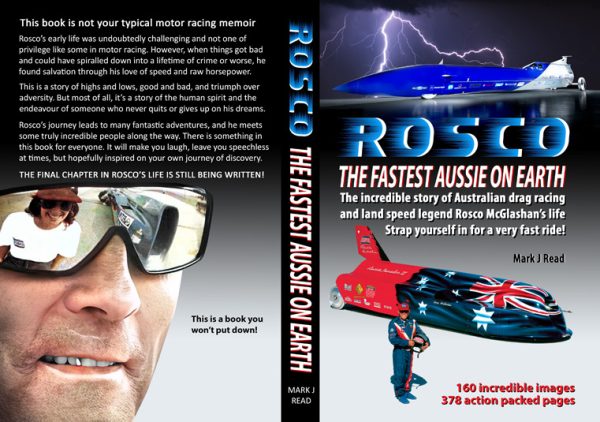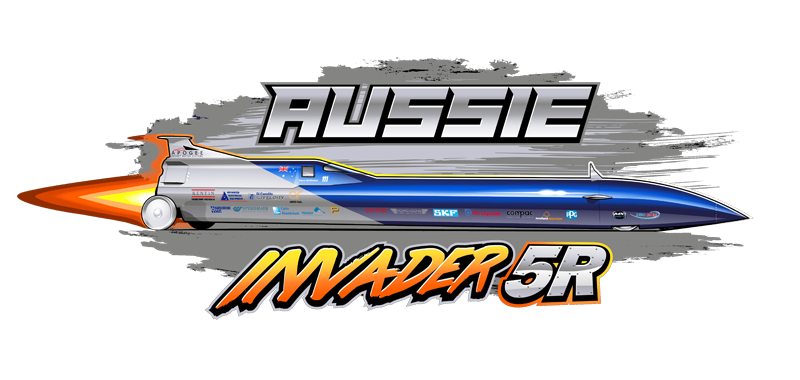The Early Drag Racing Years
Rosco left his home and school at the age of twelve after a disagreement with his Headmaster and friends. He told his friends he was going to build a car faster than Donald Campbell’s Bluebird! They didn’t believe him and he decided to prove them wrong. He travelled north in WA, increasing his age from 12 to 16 to earn money and start a racing career! His drag racing career was delayed two years when he was detained in prison at age 17.
His first competitive drive was in a Pro-Stock drag car at Surfers Paradise Drag Strip, when he was the gearbox mechanic on the car and the professional driver failed to show up. The owner of the car said, “McGlashan, you’re driving today!” On his first run, Rosco beat the professional drivers’ best quarter-mile time. He was the nominated driver from then on.
Krazy Horse V8 Drag Bike
Was a drag bike with a V8 engine from a Pro Stock drag car. Krazy Horse was originally built and run by Wally Pushkey and his team with a 292 cu. in. Ford V8. It was direct drive and so had no clutch.
Rosco would rev the V8 drag bike up to about 5,000 rpm and rock it off a stand. Krazy Horse would snake from side to side the whole length of the quarter-mile, leaving a rubber tyre mark all the way up the track. Rosco’s best time was 9.1 seconds at 170 mph (275 km/h).

Racing Jet Cars with Ken Warby
Rosco first met Ken Warby just after he had set the world water speed record at Blowerin Dam, NSW, in October 1978, and they became firm friends, working and playing together over the next few years. Ken asked Rosco to oversee two dragsters he was having built in the USA.
Once they were completed, Ken invited Rosco to join his drag racing team and drive them with him. The Ken Warby Jet Racing Spectacular we travelled to all the major drag strips throughout Australia to race these epic machines. Rosco also joined Ken on his “Thunda Down Under” tour. What a show they put on.

Rocket Powered Drag Bike
Rosco built a rocket drag bike with two small hydrogen peroxide rocket engines in 1979/1980. He learnt all he could through reading books in the local library about these engines, which the Germans used in the Second World War. He struggled to get the engines working properly and contacted USA drag racing legend and rocket pioneer “Fearless Fred” Goeske.
Once the rocket drag bike was built, Rosco tried to get it sanctioned to race. Unfortunately it was banned by the Australian National Drag Racing Association (ANDRA), for being too dangerous, and could never thrill the drag racing fans in Australia.
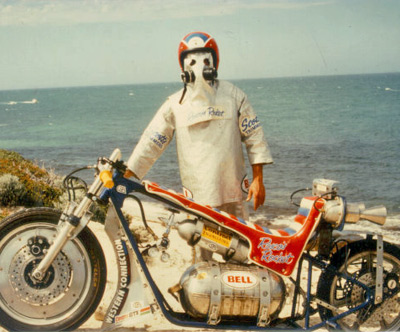
Rocket Powered Go-Kart
In 1980 Rosco visited USA drag racer “Fearless Fred” Goeske in 1980. Fred had offered advice to help him get the rocket drag bike engines working properly. Suspended from Fred’s garage roof was a rocket powered go-kart, originally built by Ky Michaelson. Rosco persuaded Fred to let him test it at a local drag racing track. Rosco had four runs in the car, culmination in a best run of 253 mph (407 km/h), in 5.97 seconds.
Rosco bought the go-kart from Fred and shipped it back to Australia. It was also banned by ANDRA, but the run in the USA is still the fastest a go-kart has ever run the 1/4 mile.
Aussie Invader 1
Aussie Invader 1 was a jet dragster initially owned by Ken Warby, who holds the World water speed record at 317 mph (511 km/h), set on Blowering Dam on 8th October 1978. The car was originally named ‘US Invader’ when Ken owned it. Rosco bought it from Ken and renamed it to Aussie Invader. It was later renamed again to Aussie Invader 1 when Rosco knew he would have other Aussie Invader jet cars.
Aussie Invader 1 wowed the drag racing crowds all over Australia and New Zealand. It was powered by a Westinghouse J34 jet engine with a purpose-built afterburner. The engine was originally fitted to the Lockheed Neptune as a Jet Assist Take Off (JATO) engine, producing about 6,500 lbs of thrust. Aussie Invader 1 set the unofficial Tasmanian land speed record in 1987 of 506 km/h (315 mph) in 1986 at a promotional charity exhibition for the Lions Club of Hobart.
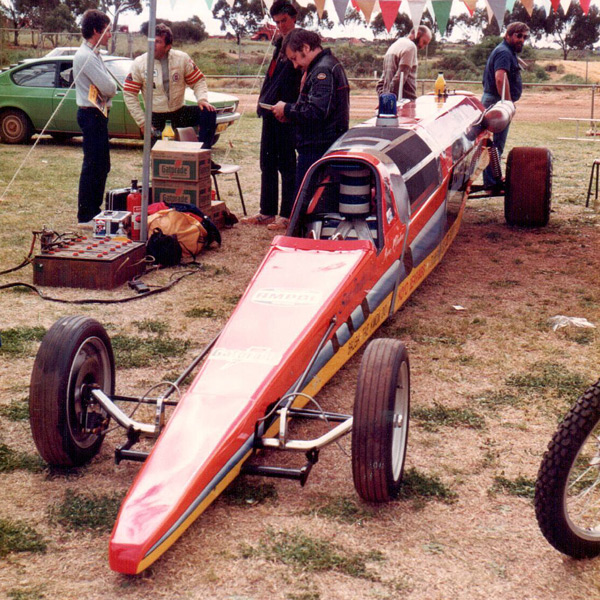
Aussie Invader 2
The construction of Aussie Invader 2 started in 1988. The car was powered by a 36,000 hp ATAR jet engine from a Mirage jet fighter. It took four years to build, and Rosco’s first attempt to set the Australian land speed record in Aussie Invader 2 was in December 1993. However, rain and poor salt/track conditions meant they were unsuccessful.
Rosco and the team returned in March 1994 and broke Donald Campbell’s Bluebird record set at Lake Eyre in 1964. After setting the Australian land speed record, Rosco and the team went after the world record, but the earlier rain had reduced the track length, and at close to 600 mph (960 km/h), Rosco found he did not have enough track to stop, so fasters speeds were out of the question. Once again they decided to pack up and return the following year, hoping for improved conditions.
The Aussie Invader team returned in February 1995 to Lake Gairdner for an assault on the 633 mph (1,013 km/h) world land speed record held by Richard Noble. Once again, the salt surface was poor and wet in places, but with time and sponsorship dollars running out, they had no other option than to persist with the world land speed record attempt. Poor track conditions meant Rosco ran off course and hit the metal timing stand at close to 600 mph. He was lucky to walk away, but unfortunately, the car was destroyed.
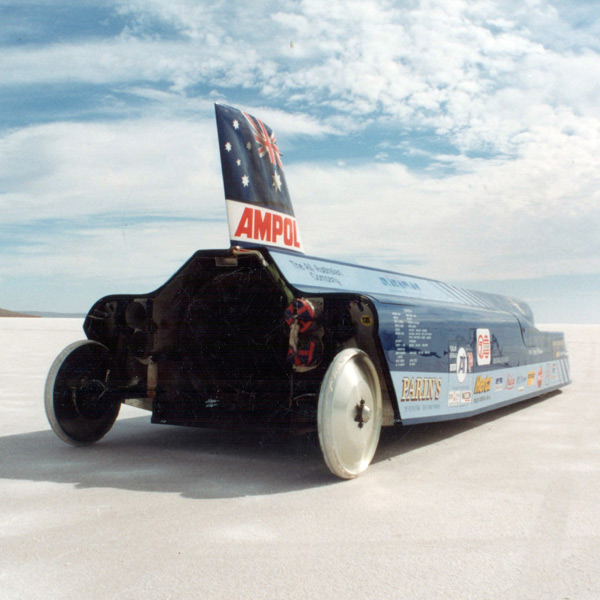
Aussie Invader 3
Rosco and his team then built his next car Aussie Invader 3, utilising another ATAR engine from a Mirage jet fighter and the modified Aussie Invader 2 chassis. This car was better aerodynamically and more powerful. Rosco hoped to challenge Andy Green and Craig Breedlove to be the first to Mach 1 on land, planning to go to Lake Gairdner in 1996. However, it constantly rained that year at the lake, making it impossible to run the car. On 15th October 1997, Andy Green reached 763 mph (1,227 km/h), the first supersonic record (Mach 1.016). This made Aussie Invader 3 redundant. So a new, more powerful car was planned.
Rosco did get a chance to drive Aussie Invader 3 at Lake Gairdner in March 2000, and to try and better his Australian record. He reached a peak speed of 638 mph (1,027 km/h), but poor salt and weather prevented a return run, so no new Australian record was recorded.
Aussie Invader 3 is the fastest car ever to be driven on a salt lake with solid aluminium wheels. In 2015. McGlashan sold Aussie Invader 3 to raise money for the Aussie Invader 5R project.
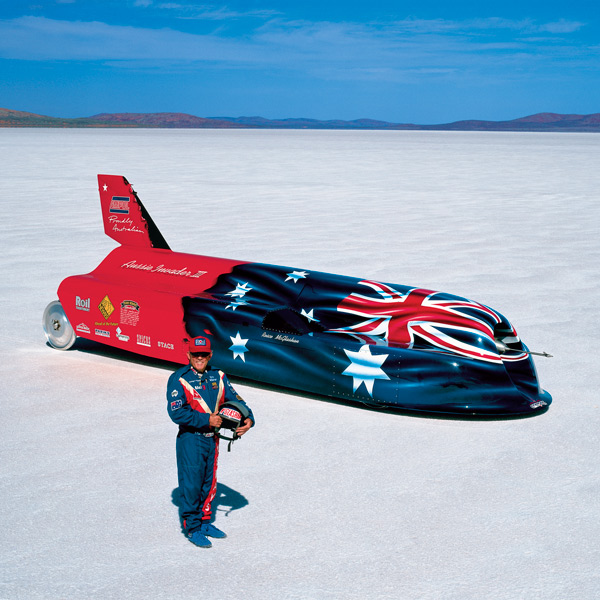
Aussie Invader 4
Like Aussie Invader 1, Aussie Invader 4 was powered by a J34 Westinghouse jet engine with a purpose-built afterburner and was capable of 0 – 280 mph (450 km/h) in about five seconds. It was completed in 1996 to race alongside Aussie Invader 1 at drag racing meeting.
Rosco would invite international guest jet dragster/funny car drivers to race Aussie Invader 4, so he could match race Aussie Invader 1 and 4 together. Both cars were sold in 2002 when Rosco wanted to concentrate his efforts on research to build Aussie Invader 5R.
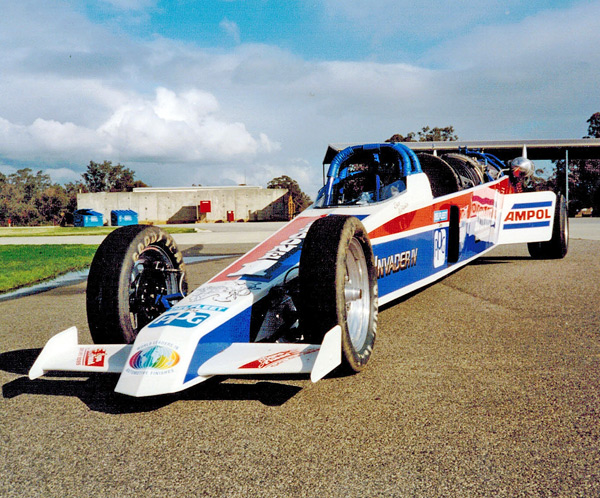
Aussie Invader 5R
After Thrust SSC went Mach 1.02 (763 mph), Rosco knew he needed a car with a lot more power. He started planning to build a rocket-powered car capable of smashing the sound barrier and achieving 1,000 mph (1,600 km/h). Construction on the car started in 2009, after preliminary planning and design work, which took close to a decade before the build could start.
Work on building Aussie Invader 5R has now reached the end of phase 1 (completed car with systems in place). Phase 2 is underway, trying to raise funding to test and fine-tune the 62,000-pound thrust rocket engine, which is equivalent to about 200,000 hp, about the power of 200 Formula One cars.
Aussie Invader 5R will be the biggest and most powerful land speed car Rosco has built. It is 16m (52ft) in length and 3m (10ft) high at the tail fin. It will weigh 6.3 tonnes dry (unfuelled) and a massive 9.2 tonnes when loaded with propellants (fuel and oxidizer). It will burn around 2.5 tonnes of propellants in about 22 seconds on a full high-speed run. It will take about 3.5 miles (5.6 km) to get up to speed and run the measured and timed mile/kilometre. It will take about 8 miles (12.8 km) to stop.

Further Reading
If you want to learn more about Rosco’s incredible drag racing and land speed record career, then you should read the new best-selling book – ROSCO The Fastest Aussie on Earth. It has been an Amazon #1 best-seller in several categories and tells his remarkable story from a very tough childhood to prison at 17, and his salvation, through his love of speed and drag racing. Please don’t just take our word for it, read the reviews online from people who have read the book.
We know you will enjoy this true story of Rosco’s incredible life in 380 action-packed pages, with 160 amazing photos. We are sure you won’t put it down, once you start reading.
